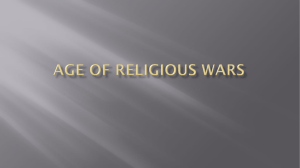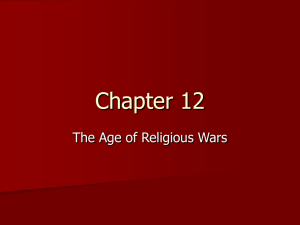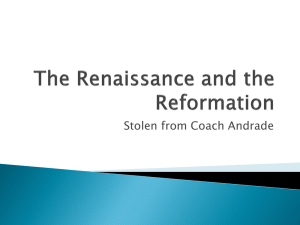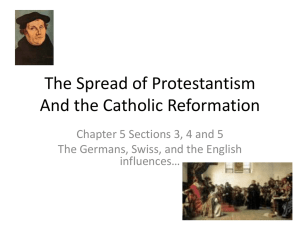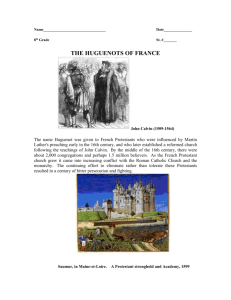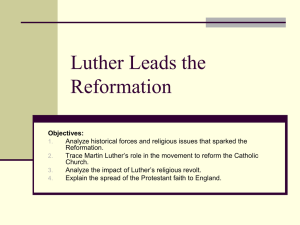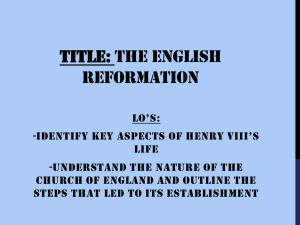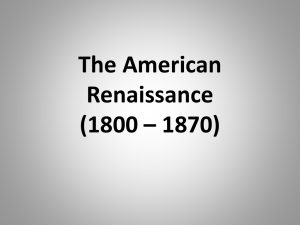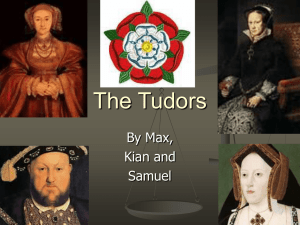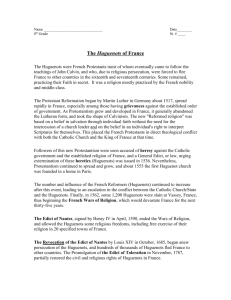The Western Heritage Since 1300
advertisement
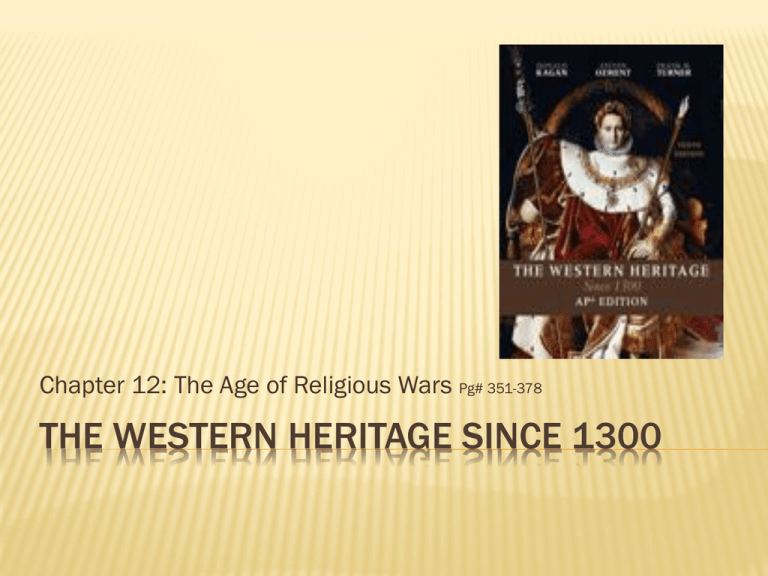
Chapter 12: The Age of Religious Wars Pg# 351-378 THE WESTERN HERITAGE SINCE 1300 KEY TOPICS: The War between Calvinists & Catholics in France The Spanish occupation of the Netherlands(Holland) The struggle for supremacy between England and Spain The devastation of central Europe during the Thirty Years’ War CHAPTER OUTLINE: Renewed Religious Struggle The French Wars of Religion (1562-1598) Imperial Spain and Philip II (1556-1598) England and Spain (1553-1603) The Thirty Years’ War (1618-1648) EUROPE VOCABULARY: Presbyters Imperial Diet Treaty of Westphalia skepticism baroque relativism congregationalist Thirty Years’ War Counter-Reformation Huguenots politique Habsburg Presbyterians Thirty-Nine Articles (1563) colloquy synod Edict of Nantes Fuggers escorial regicide semi-autonomous hierarchical secular principalities RENEWED RELIGIOUS STRUGGLE Roman Catholic Church vs Protestantism MAP OF EUROPE: 16TH & 17TH CENTURY ST. BARTHOLOMEWS DAY MASSACRE https://www.youtube.com/watch?v=vwjAb9T6q Is THE FRENCH WARS OF RELIGION Henry II of France Francis II Catherine de Medici Catholicism vs Protestantism in France 1. French Protestants known as Huguenots, derived from Besancon Hugues, leader of Geneva’s political revolt against House of Savoy in the 1520’s 2. Anti-Protestant feelings throughout France common, persecution as well. 3. 1540, Edict of Fontainbleau subjected French Protestants to Inquisition a. Catholic imprisonment/torture to recant Protestant beliefs 4. French monarchs including Henry II (1547-1559), enacted laws against Protestant worship/public gatherings 5. Henry II’s death due to accident, son took over only to die a year later, opened rule for other families of France THE FRENCH WARS OF RELIGION Home of Henry II of France & Catherine de Medici THE FRENCH WARS OF RELIGION Admiral Gaspard de Coligny 6. Three families vied for control of France: a. Bourbons (south & west) b. Montmorency-Chatillons (center) c. Guises (east) 7. Guise family controlled Francis II, the son of Henry II, as two brothers Cardinals in Church, one Henry’s top general, also related to Mary, Queen of Scots, widow of Francis II, son of Henry, all known as reactionary militant Catholics 8. aBourbon & bMontmorency-Chatillon families formed ties with Huguenonts a. Bourbon prince Louis I, Prince of Conde b. Admiral Gaspard de Coligny c. both political leaders of French Protestant resistance Louis I, Prince of Conde APPEAL OF CALVINISM 1. Huguenots (Protestants) a minority religion in France a. 1561, 2,000 Huguenot congregations in France b. only a majority in two regions of FranceDauphine & Languedoc c. 2/5’s French aristocracy Huguenot 2. Calvin justified & encouraged resistance of Huguenots against Catholic rule in France, made Protestant religion viable in France CATHERINE DE MEDICI & THE GUISES Francis II Catherine de Medici 1. Catherine became regent to Francis II as Francis too young to rule independently 2. Attempts to reconcile Catholic vs Protestant issues failed, goal to preserve monarchy 3. 1562, issued January Edict, which granted Protestants right to worship publicaly outside towns-though to worship inside while in towns and hold synods(mtg of Protestant churches) 4. Duke of Guise surprised Protestant congregation at Vassy (Champaigne) and killed several worshippers 5. Beginning of French Wars of Religion Duke of Guise CATHERINE DE MEDICIS https://www.youtube.com/watch?v=zjKBax-tuM THE PEACE OF SAINT-GERMAINE –EN-LAYE 1. Series of Wars: a. April 1562-March 1563 Duke of Guise assassinated b. 1567-1568 c. September 1568-August 1570 Louis I, Prince of Conde killed Huguenot leadership passed to Coligny THE PEACE OF SAINT-GERMAINE –EN-LAYE 2. Peace of Saint-Germaine, 1570 French crown recognized Huguenot political & military power a. Huguenots granted religious freedom, right to fortify their own cities 3. Political intrigue as Catherine, a Catholic, sought to balance power between Huguenots & Bourbons a. she wanted to prevent Huguenot support for Dutch Protestants, including military assistance because Spain controlled the Netherlands, which would have meant war between France Queen Catherine de Medici and Spain, and France was weaker. ST. BARTHOLOWMEW’S DAY MASSACRE https://www.youtube.com/watch?v=yTC_s_YWI FI SAINT BARTHOLOMEW’S DAY MASSACRE 1. Catherine part of plot to kill Admiral Gaspard de Coligny as he was shot by assassin. a. convinced Charles, Holy Roman Emperor that Huguenot plot to take over France, inspired by Coligny, and to execute all Huguenot leaders 2. August 24, 1572, Coligny & 3,000 others butchered in Paris a. 20,000 killed overall in France by French Catholics b. Pope Gregory XIII & Philip of Spain greeted news with celebrations c. Philip happy as prevented France from interfering with Netherlands Protestants d. St. Bartholomew’s Day massacre became symbol of Catholic oppression over Protestants, world-wide PROTESTANT RESISTANCE THEORY 1. Protestant theory of active resistance against oppression a. Luther only approved active resistance after Diet of Augsburg, 1530 b. 1550, Lutherans published paper defending right of lower authorities to oppose Emperor’s order that all Lutherans return to Catholic fold c. Calvin taught that lower magistrates had right to oppose tyrannical higher authority d. John Knox, who suffered defeat at the hands of Mary, Queen of Scots, (Catholic) wrote First Blast of Trumpet against the Terrible Regiment of Women (1558), declared removal of heathen tyrant was permissible & Christian duty PROTESTANT RESISTANCE THEORY 2. Francios Hotman wrote Franco-Gallia, 1573, based on theory that French Estates General held higher power than French Kings 3. Theodore Beza wrote On the Right of Magistrates over Their Subjects, (1574), justified correction and even overthrow of tyrannical rulers by lower authorities 4. Philippe du Plessis Morney wrote Defense of Liberty against Tyrants, (1579), admonished princes, nobles, magistrates beneath king as guardians of the rights of the body politic, to take up arms against tyranny in other lands THE RISE TO POWER OF HENRY OF NAVARRE Henry III of France 1. Henry III of France (1574-1589), attempted to steer middle course between Huguenots & a radical Catholic League, formed in 1576 by Henry of Guise a. Henry received support from moderate Catholics & Huguenots who felt survival of France greater than religious civil war, this politique was prepared to offer compromise between religions 2. Peace of Beaulieu, May 1576, granted Huguenots almost complete religious freedom 3. Peace would not last as Catholic League forced Henry to return to quest for absolute religious unity in France a. Henry removed Peace of Beaulieu, October 1577, again limited Huguenot worship 4. Religious war once again between Catholics & Huguenots THE RISE TO POWER OF HENRY OF NAVARRE 5. “Day of the Barricades”, Henry’s attempt to route Catholic League failed, Henry fled Paris, reduced to fighting with guerrilla tactics against stronger opponent a. Had Duke & Cardinal of Guise assassinated upon hearing of English victory over Spanish Armada in 1588 b. Another Guise led Catholic League against Huguenots, another massacre similar to earlier St. Bart’s massacre c. Henry struck alliance with Henry of Navarre, Protestant 6. Henry III killed by Catholic Dominican Friar after which meant Henry of Navarre became Henry IV(1589-1610) Henry III of France 7. Spanish troops were sent to support French Catholic League as Spain and Pope did not want Protestant France a. Henry IV, popular with the troops, tired of religious fighting, focused on political peace over religious unity 8. July 25, 1593, publically abandoned Protestant faith, embraced traditional & majority religion of France “Paris is worth a mass”, as felt religious tolerance best way to achieve peace a. Protestants horrified, Pope Clement VIII skeptical, though French sided with Henry IV. b. Catholic League disbanded, 1596, Wars of Religion over Henry of Navarre(Henry IV)
